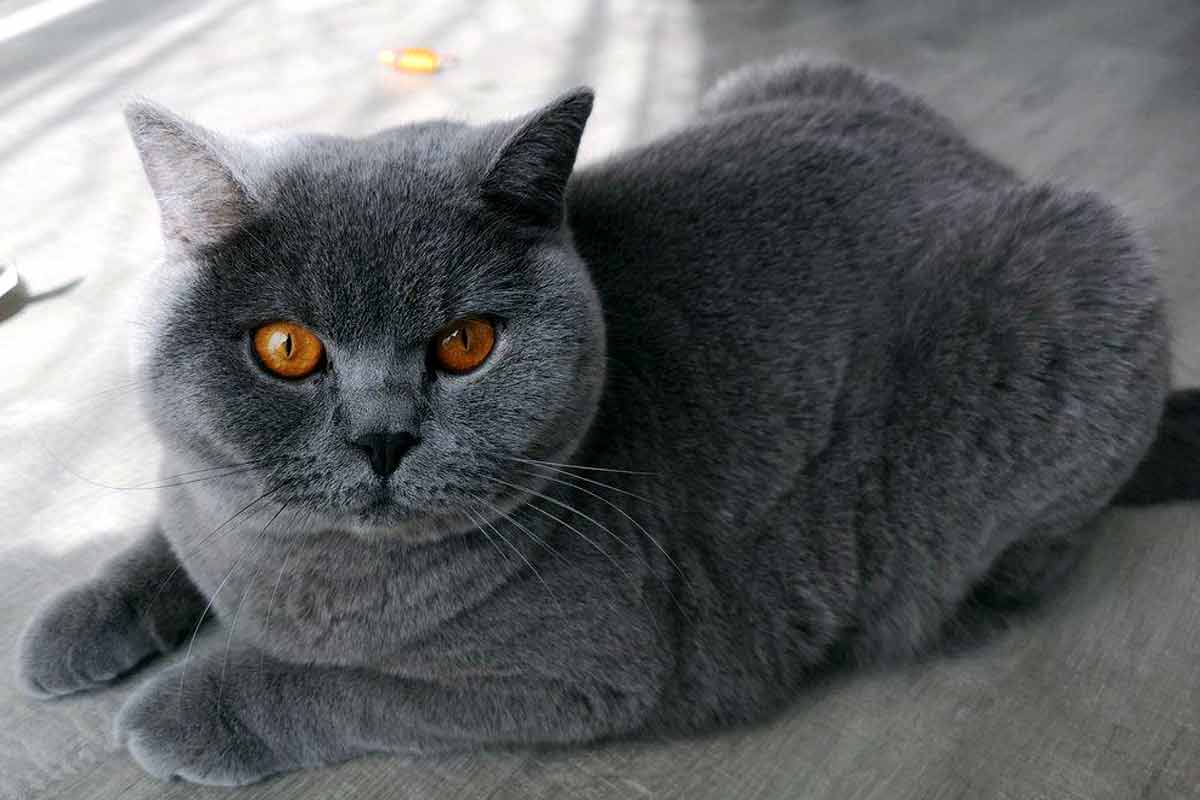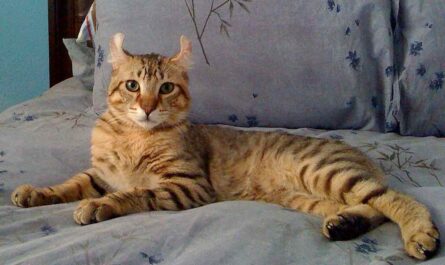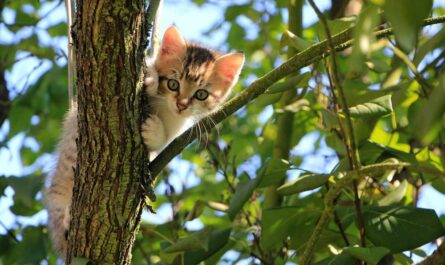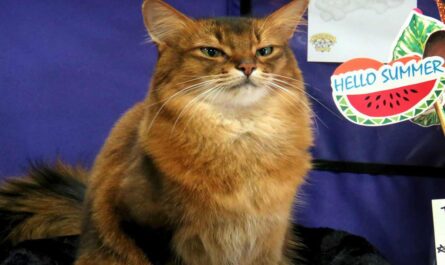What is a British Shorthair Cat breed, its profile, behavior, traits, lifespan, health, training, personality, diet, grooming, care, and other interesting facts? In the fantastical realms of Alice in Wonderland, where whimsy and absurdity dance a peculiar waltz, the Cheshire Cat emerges as an icon of feline intrigue. What many aficionados of Lewis Carroll’s literary masterpiece may not discern is the subtle but profound connection between this mischievous grinner and the British Shorthair breed. The Cheshire Cat, with its enigmatic smile and ephemeral disposition, finds its muse in the stoic countenance and distinct features of the British Shorthair. It’s a testament to how the tangible and the fantastical can intertwine, creating a surreal tapestry where fiction borrows from the quirks of reality. This article will share insight into the profile, behavior, traits, lifespan, health, training, personality, grooming, care, diet, and other interesting facts about the British Shorthair cat breed. Keep reading.
British Shorthair Cat History
The captivating history of the British Shorthair cat traces back to the first century A.D. when Roman invaders brought cats to Britain for pest control. These early felines interbred with local wildcats, resulting in a distinctive appearance. Artist Harrison Weir, a key figure in the breed’s development during the 19th century, played a pivotal role in selecting for the blue-gray variant that evolved into the British Blue.
The breed faced near extinction during both World Wars, prompting breeders to introduce Persians, Russian Blues, and French Chartreux to revitalize bloodlines. This effort not only saved the British Shorthair but also led to the creation of British Longhair cats. Recognition by the American Cat Association in 1967 marked a significant milestone, and by 1980, the British Shorthair gained recognition from The International Cat Association and the Cat Fanciers Association. The breed’s resilience and adaptability are evident today, with British Shorthairs available in a myriad of colors, yet the timeless appeal of the classic blue hue remains a favorite among enthusiasts.
British Shorthair Breed Temperament
The British Shorthair cat breed is renowned for its multifaceted temperament, exhibiting a harmonious blend of affectionate, easygoing, and sensible qualities. These feline companions bring an unparalleled sense of tranquility and warmth to their human counterparts, fostering a bond that transcends the mere pet-owner dynamic. Their affectionate nature is manifested through gentle purrs, nuzzles, and a penchant for seeking proximity, creating an environment enriched with emotional reciprocity.
The ease with which they adapt to various living conditions is a testament to their easygoing disposition, making them suitable companions for individuals with diverse lifestyles. Furthermore, their sensible demeanor adds a layer of discernment to their interactions, making them astute observers of their surroundings, and contributing to a more nuanced and sophisticated companionship.
British Shorthair Cat Personality
Once recognized exclusively as the British Blue, the British Shorthair cat has evolved beyond its origins to encompass a diverse array of colors while retaining its quintessential rounded profile and somewhat reserved yet delightful personality. These pedigreed felines, descendants of British domestic shorthair cats, have undergone selective breeding to craft a distinct appearance and predictable temperament.
In essence, British Shorthair cats are familial beings, harboring an affectionate disposition toward their human cohorts. However, their unique personality traits set them apart; they revel in staying close but exhibit a preference for lounging adjacent to their owners rather than indulging in extensive cuddling sessions. Notoriously independent, they aren’t overtly demanding or excessively vocal. While they make excellent pets for a variety of households, their aversion to disrespect and reluctance to be held or carried places them in a category that demands a nuanced understanding of their boundaries.
These distinctive traits should not be misconstrued as indicative of a mean or antisocial personality. Rather, they serve as signposts directing potential owners toward considerations of compatibility. While British Shorthair cats can thrive in most households, their temperament suggests that families with young children, who may not fully comprehend boundaries, might find better matches in other feline companions. Understanding and respecting the British Shorthair’s unique blend of independence and affection forms the cornerstone of a fulfilling and harmonious feline-human relationship.
Behavioral Contrasts in Male and Female British Shorthair Cats
In the realm of feline idiosyncrasies, the enigmatic behavioral tapestry woven by male and female British Shorthair cats unravels with distinctive threads. It’s not merely a matter of gender; it’s a nuanced symphony of temperament. The feline maestros of the male persuasion exhibit a laissez-faire, easy-going attitude, navigating life’s intricacies with a nonchalant finesse that almost borders on the philosophical. On the other end of the behavioral spectrum, their female counterparts don a cloak of seriousness, a gravitas in their approach to existence. Life, for them, is not a whimsical dalliance but a profound journey deserving meticulous consideration.
Prowess in Patience: The Gradual Maturation of British Shorthair Cats
In the intricate dance of biological timelines, British Shorthair cats pirouette at a pace that defies the hurried rhythms of their feline counterparts. The notion of swift maturation finds little resonance in their world. Instead, these feline connoisseurs of contemplation take their sweet time to unfurl into the fullness of their being. Most, by the culmination of their third year, achieve the zenith of their physical stature, a testament to the deliberate cadence at which they approach adulthood. However, outliers exist within this temporal ballet, with some individuals extending their maturation sojourn to a languorous five years. It’s as if these cats have an unspoken agreement with time, choosing to saunter through the corridors of maturity rather than sprinting through them.
Other Names
Beyond the commonly recognized nomenclature of British Shorthair, this venerable feline breed is known by the alternate epithets of Britanica and Lowlander. These alternative monikers not only underscore the breed’s diverse cultural associations but also reveal the rich tapestry of its global recognition. The name is Britanica exudes a sense of regality, conjuring images of a cat with a refined and aristocratic demeanor. On the other hand, the designation Lowlander hints at a connection to geographical landscapes, perhaps invoking the idea of a cat well-suited to lowland regions. These alternative names provide an intriguing linguistic lens through which one can explore the multifaceted identity of this beloved feline.
Affection Level
The British Shorthair cat breed, with its distinctive charm and affable disposition, falls comfortably into the category of feline companions characterized by a high affection level. These cats exude a genuine desire to both give and receive copious amounts of attention. Their affectionate nature is not merely a fleeting display but an integral aspect of their personality, creating an environment where reciprocal love and companionship flourish. Whether through soft purrs, gentle headbutts, or a penchant for curling up near, the British Shorthair actively seeks out moments of connection with their human counterparts. This high level of affection contributes to a deep and meaningful bond, elevating the pet-owner relationship into a rich tapestry of emotional interconnectedness.
British Shorthair Cat Playfulness
The British Shorthair cat breed, with its innate playfulness, emerges as a delightful and engaging playtime companion. Scoring high in this area, these feline wonders exhibit strong hunting instincts, transforming play sessions into captivating adventures. Their agile movements and precise pounces reflect not only a keen sense of play but also an embodiment of their natural hunting prowess. This playfulness adds a layer of dynamism to the pet-owner relationship, as the British Shorthair invites their human counterparts into a world of interactive amusement, creating a vibrant tapestry of shared joy and energetic camaraderie.
Independence
The British Shorthair, with its unique blend of sociability and independence, navigates the spectrum of feline self-sufficiency with grace. Possessing a noteworthy score in independence, these cats showcase the ability to spend extended periods alone, indulging in solitary pursuits and contemplation. This independence does not, however, translate to aloofness; rather, it reflects a self-assured demeanor that coexists harmoniously with their affectionate nature. The British Shorthair’s capacity for solitude makes them ideal companions for individuals with busy schedules, contributing to a balanced and adaptable feline-human companionship.
British Shorthair Breed Vocality
In the symphony of feline communication, the British Shorthair cat breed strikes a harmonious balance, earning a moderate rating in vocality. While not prone to excessive meowing and vocalizations, these cats express themselves thoughtfully and purposefully. Their communication style is nuanced, incorporating gentle purrs, soft trills, and occasional meows to convey their needs and desires. This measured approach to vocalization creates an environment where the British Shorthair communicates effectively without overwhelming the auditory landscape. Their ability to stay quiet when needed adds a layer of tranquility to the household, making them suitable companions for those seeking a more serene and peaceful cohabitation.
Activity Level
In the realm of activity levels, the British Shorthair gracefully holds its ground, balancing engagement and poise. While not characterized by exuberant hyperactivity, these cats are by no means lethargic. Instead, they display a measured and deliberate approach to play, engaging in activities that showcase both their agility and grace. Their playfulness is manifested in precise movements, making them adept hunters of toys and, on occasion, even shadows. This moderate activity level suggests an appreciation for both active play and serene contemplation, providing a well-rounded companionship experience. This nuanced approach to activity ensures that the British Shorthair cat can seamlessly integrate into a variety of living spaces, adapting to the pace of their human companions.
Pet-Friendly
Navigating the intricate social dynamics of a household, the British Shorthair cat breed emerges as a remarkably pet-friendly companion. Their ability to harmoniously coexist with other cats, dogs, and assorted pets sets them apart as versatile additions to multi-pet households. With a blend of sociability and a calm demeanor, these cats often extend the paw of friendship, fostering camaraderie with their fellow four-legged companions. Their adaptable nature allows for a smooth integration into the complex web of pet relationships, creating a harmonious living environment. Whether engaged in amicable play sessions or sharing a sunlit spot for communal lounging, the British Shorthair’s pet-friendly disposition enriches the tapestry of interconnected pet relationships within a household.
British Shorthair Cat Kid-Friendly
The British Shorthair cat breed, with its inherently gentle and patient demeanor, effortlessly earns a high rating in the realm of kid-friendliness. These feline companions possess a remarkable ability to navigate the energy and exuberance of children with grace and composure. Their patient nature allows for seamless integration into households with young ones, where the occasional exuberant play or affectionate cuddles are met with tolerance and even reciprocated with gentle purrs. The British Shorthair’s kid-friendly disposition transforms them into not just furry companions but steadfast and understanding playmates, fostering a bond that contributes to the enriching tapestry of a family dynamic.
Sociability
The British Shorthair, with its affable and sociable nature, shines brightly in the realm of feline companionship. Possessing a higher sociability rating, these cats actively seek out human interaction and companionship, making them ideal for individuals craving a feline friend always by their side. The British Shorthair’s desire to spend time with their human counterparts transcends mere cohabitation; it evolves into a genuine yearning for shared moments, be it in the form of quiet companionship or interactive play. This heightened sociability creates an atmosphere of warmth and connection, where the British Shorthair becomes not just a pet but an integral part of the human social fabric.

Breed Standard of British Shorthair Cat
Eyes:
In adherence to the breed standard, the British Shorthair cat boasts large and round eyes, positioned level and set generously apart. The captivating gaze of these feline companions can be of any color that harmonizes with the cat’s coat color, adding a touch of individuality to their mesmerizing visage.
Legs & Paws:
The British Shorthair’s legs are a testament to strength and proportion. Straight and well-proportioned, they exhibit a robust musculature that complements the cat’s overall physique. This blend of strength and grace extends to their paws, completing a picture of a feline with a sturdy and well-balanced stance.
Tail:
The tail of the British Shorthair adheres to the breed standard with its medium length, featuring a thick base that gradually tapers to a well-rounded tip. This tail design contributes to the cat’s overall balance and poise, enhancing their visual appeal.
Body:
The British Shorthair is characterized by a substantial and rounded body, reflecting its status as a large feline breed. Compact and powerful, these cats boast a broad chest and sturdy hips, embodying an impressive physical presence. Mature males can weigh up to 17 pounds, while females can reach 12 pounds, further emphasizing the breed’s robust build.
Head:
The head of the British Shorthair is a masterpiece of symmetry, featuring a well-rounded shape atop a short, thick neck. The forehead is gently rounded, with a subtle flattening toward the top of the skull. Both genders showcase jowls, with males exhibiting more pronounced jowls than their female counterparts. The muzzle is well-developed, with prominent whisker pads, creating the distinctive “smile” that is a hallmark of the British Shorthair cat.
Ears:
British Shorthair cats adhere to the breed standard with medium-sized ears that are broad at the base and rounded at the tips. Positioned far apart, the outer edges continue the rounded contour of the head, contributing to the breed’s overall aesthetic appeal.
Coat:
The British Shorthair’s coat is a showcase of density without being double-layered. This thick coat enhances the cat’s physical presence and provides a luxurious tactile experience for those fortunate enough to share their living space with these regal felines.
Color:
A canvas of diversity, British Shorthair cats may flaunt a coat of any color and pattern. The breed standard embraces this variety, allowing for a spectrum of hues and designs that contribute to the cat’s unique and individualized appearance. Nose leather and paw pad color complement the overall coat color, creating a harmonious visual composition.
Intelligence
In the intricate landscape of feline intelligence, the British Shorthair cat breed strikes a balance between curiosity, investigative prowess, and trainability. Their higher intelligence rating reflects a natural inclination towards exploration and a keen interest in their surroundings. This curiosity not only contributes to their agile play but also makes them adaptable to new experiences. The British Shorthair’s trainability further underscores their intelligence, as they exhibit a receptiveness to learning tricks and commands. This blend of inquisitiveness and a trainable nature positions them as feline companions that not only provide entertainment through their clever antics but also respond to the enriching experiences of shared learning and engagement
Life Expectancy
The British Shorthair, with its distinctive charm and robust constitution, boasts a life expectancy ranging from 12 to 16 years. This time allows for a profound and enduring companionship between these cats and their human counterparts. The longevity of their lives becomes a canvas upon which shared experiences, from playful kittenhood to the dignified grace of maturity, are painted. It also emphasizes the responsibility of cat owners to provide not just immediate care but also a nurturing environment conducive to a full and healthy lifespan. This extended life expectancy places the British Shorthair in a unique position, offering the potential for a lifetime of shared moments, creating a tapestry of memories that weaves together the threads of feline and human existence.
British Shorthair Breed Care
Caring for a British Shorthair cat involves a thoughtful blend of attention to their unique physical characteristics and overall well-being. Their dense, plush coat benefits from regular grooming sessions to minimize shedding and maintain its velvety texture. Periodic brushing, at least a couple of times a week, helps in keeping their coat in optimal condition. Dental care is crucial, and routine teeth brushing should be incorporated into their care routine to prevent dental issues. Regular vet check-ups are essential to monitor their health and address any potential concerns promptly. Additionally, creating a stimulating environment with toys and scratching posts can contribute to their mental well-being.
Nutrition
A balanced and appropriate diet is paramount for the health of a British Shorthair cat. Due to their rounded physique, there is a tendency for these cats to gain weight, so a diet tailored to their needs is crucial. High-quality cat food, formulated for their specific life stage, is recommended. Portion control is essential to prevent obesity, a common concern for this breed. Adequate water intake is also crucial to support their overall health. Consulting with a veterinarian to determine the most suitable diet plan and monitoring their weight regularly are integral aspects of maintaining optimal nutrition for British Shorthair cats.
Cost of British Shorthair Cats
The acquisition of a British Shorthair cat is an investment that spans a spectrum of financial commitments. The financial landscape of bringing home one of these feline wonders is diverse, with prices ranging from a modest $300 to a staggering $5,000. This broad price range is influenced by various factors, such as the cat’s pedigree, age, coloration, and overall quality. The allure of a British Shorthair cat comes not only from its distinctive appearance but also from its charming personality, making the monetary investment a reflection of the unique qualities this breed embodies.
Size and Stature of British Shorthair Cats
Delving into the physical dimensions of the British Shorthair cat unveils a creature of moderate proportions. This felid, upon reaching maturity, typically attains a weight spanning the range of 8 to 18 pounds, or perhaps even surpassing these figures in certain instances. The height of a fully grown British Shorthair cat meanders between 11 to 14 inches, a range that contributes to their stately presence. It is within these dimensions that the essence of the breed’s medium size is encapsulated, portraying a harmonious balance between compactness and robustness.
The Lifespan of British Shorthair Cats
Embarking on the journey of pet ownership requires an understanding of the temporal commitment involved. In the case of British Shorthair cats, their lifespan forms a narrative that unfolds over an average of 12 to 16 years. This temporal spectrum encapsulates the potential years of companionship, joy, and shared moments with these feline friends. However, it is important to note that individual variations may occur, influenced by factors such as genetics, healthcare, and the quality of life provided to the cat.
Shedding Habits of British Shorthair Cats
The coat of a feline companion is not merely an aesthetic element but also a practical consideration for potential pet owners. In the realm of British Shorthair cats, their short-haired nature bestows upon them a distinctive quality – a reduced propensity for shedding. Unlike their long-haired counterparts, these felines do not engage in copious shedding, making them an ideal choice for individuals who appreciate a more low-maintenance grooming routine. This characteristic, intertwined with their charming personalities, further solidifies the appeal of British Shorthair cats as a companion worthy of consideration.
Exercise
While not the most energetic of feline companions, British Shorthair cats benefit from regular and moderate exercise to keep them physically and mentally stimulated. Interactive play sessions with toys that mimic hunting activities are ideal. Engaging them in activities that encourage movement, such as chasing feather wands or laser pointers, can help prevent weight gain and promote a healthy lifestyle. However, it’s essential to be mindful of their somewhat reserved nature and not overwhelm them with overly vigorous play. Providing opportunities for climbing and exploration, such as cat trees or shelves, caters to their inquisitive disposition and contributes to a well-rounded exercise routine.
Grooming
When it comes to grooming, the British Shorthair cat breed strikes a harmonious balance, earning a lower grooming score. While these cats exhibit a plush and dense coat, the maintenance requirements are relatively modest compared to breeds with higher grooming scores. Regular brushing is beneficial to minimize shedding and maintain the luscious quality of their fur, but the British Shorthair is, in essence, a breed that leans towards being virtually maintenance-free. This makes them an ideal choice for individuals seeking the joy of feline companionship without the exhaustive grooming demands that some other breeds may necessitate. Cat accessories on Amazon
Health
British Shorthair cats, while not having specific nutritional needs, are predisposed to obesity as they age. Maintaining their health involves providing a high-quality diet, emphasizing low carbohydrates and high protein to mitigate weight gain. Despite their short coat, shedding is a common trait, and regular brushing two to three times a week becomes crucial to prevent fur accumulation and minimize the formation of hairballs. Dental care, including regular teeth brushing, contributes to overall health, while routine nail trims aid in preventing furniture damage. Though their playful nature may wane with age, encouraging engagement with interactive toys helps stimulate mental and physical well-being. See why thousands of cats love BoxCat
British Shorthair cats are generally robust and enjoy good health. However, breed-specific genetic disorders include hemophilia B and hypertrophic cardiomyopathy. Responsible breeders screen parents for these conditions, reducing the risk of offspring inheriting these disorders. While it’s impossible to guarantee the absence of hypertrophic cardiomyopathy, screening mitigates the chances, emphasizing the importance of thorough checks when considering a British Shorthair.
Other Interesting Articles
- Turkish Vankedisi Cat Profile, Traits, Health, Grooming, Care
- Ukrainian Levkoy Cat Breed: Profile, Traits, Grooming, Care
- Ussuri Cat Breed: Profile, Traits, Personality, Grooming, Care
- York Chocolate Cat Breed: Profile, Traits, Health, Care
- Tonkinese Cat Breed: Profile, Traits, Health, Grooming, Care
- Siberian Cat Breed: Profile, Traits, Health, Grooming, Care
- How to Perfectly Place A Litter Box for Your Cat? 46 FAQs
- 17 Best Types of Toys to Play at Home with Your Cat
- Snowshoe Cat Breed: Profile, Traits, Health, Grooming, Care
- Munchkin Cat Breed: Profile, Traits, Personality, FAQs, Care
- Minuet Cat Breed: Profile, Traits, Personality, Grooming, Care
- Persian Cat Breed: Profile, Traits, Personality, Health, Care
- Ragdoll Cat Breed: Profile, Traits, Personality, Grooming, Care
- Scottish Fold Cat Breed: Profile, Traits, Personality, FAQs, Care
- Russian Blue Cat Breed: Profile, Traits, Personality, FAQs, Care
- Balinese Cat Breed: Profile, Traits, Personality, Care, Facts
- Australian Mist Cat Breed: Profile, Traits, Personality, Care
- Abyssinian Cat Breed: Profile, Traits, Personality, Care, Facts
- Bengal Cat Breed: Profile, Traits, Personality, Care, Grooming
- Birman Cat Breed: Profile, Traits, Personality, Care, Grooming



